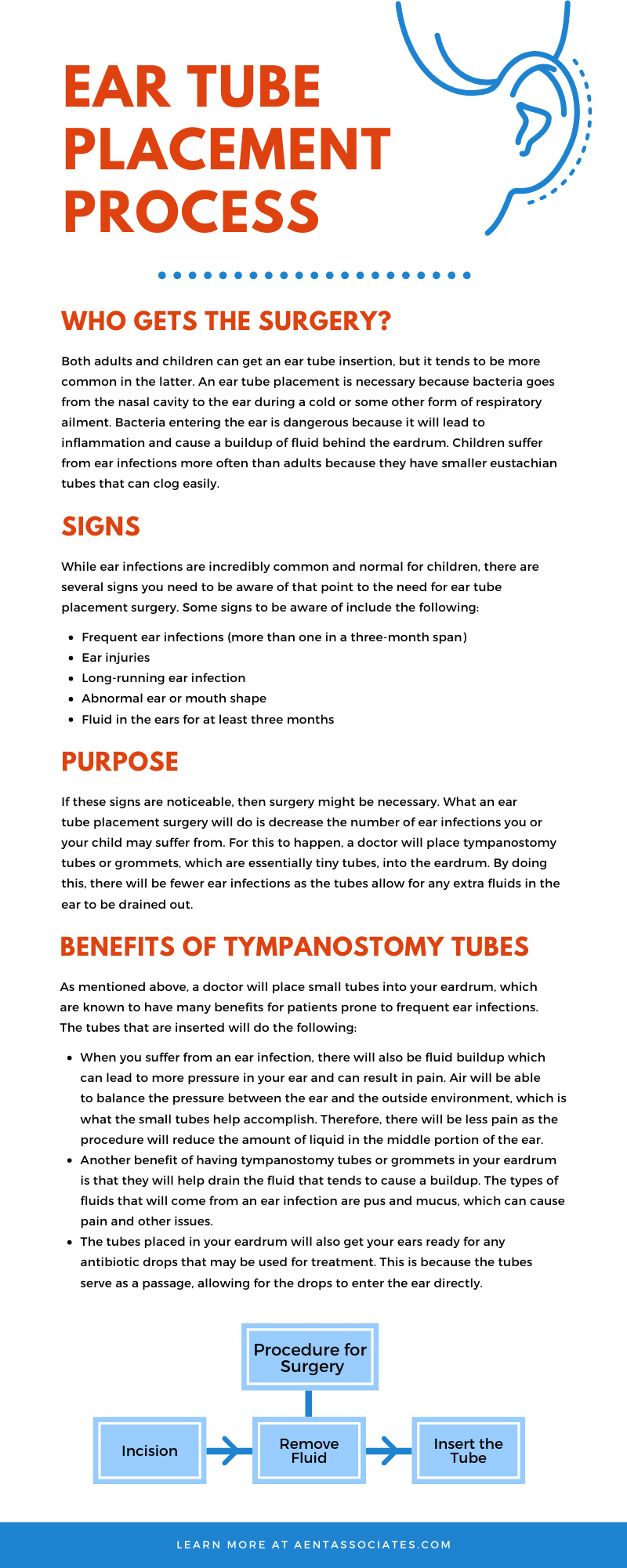
Our eardrums are thin pieces of tissue that are a vital part of ears. However, there are instances when complications may arise, like infections which can cause a lot of pain and discomfort. This pain can occur within the space behind the eardrum that is known as the middle ear in instances when the (eustachian) tube that connects it to the nose doesn’t function properly. To treat the issue, you may need to get a type of surgery which is known as ear tube insertion. To learn more about the surgery, continue reading below.
Who Gets the Surgery?
Both adults and children can get an ear tube insertion, but it tends to be more common in the latter. An ear tube placement is necessary because bacteria goes from the nasal cavity to the ear during a cold or some other form of respiratory ailment. Bacteria entering the ear is dangerous because it will lead to inflammation and cause a buildup of fluid behind the eardrum. Children suffer from ear infections more often than adults because they have smaller eustachian tubes that can clog easily.
Signs
While ear infections are incredibly common and normal for children, there are several signs you need to be aware of that point to the need for ear tube placement surgery. Some signs to be aware of include the following:
- Frequent ear infections (more than one in a three-month span)
- Ear injuries
- Long-running ear infection
- Abnormal ear or mouth shape
- Fluid in the ears for at least three months
Purpose
If these signs are noticeable, then surgery might be necessary. What an ear tube placement surgery will do is decrease the number of ear infections you or your child may suffer from. For this to happen, a doctor will place tympanostomy tubes or grommets, which are essentially tiny tubes, into the eardrum. By doing this, there will be fewer ear infections as the tubes allow for any extra fluids in the ear to be drained out.
Benefits of Tympanostomy Tubes
As mentioned above, a doctor will place small tubes into your eardrum, which are known to have many benefits for patients prone to frequent ear infections. The tubes that are inserted will do the following:
- When you suffer from an ear infection, there will also be fluid buildup which can lead to more pressure in your ear and can result in pain. Air will be able to balance the pressure between the ear and the outside environment, which is what the small tubes help accomplish. Therefore, there will be less pain as the procedure will reduce the amount of liquid in the middle portion of the ear.
- Another benefit of having tympanostomy tubes or grommets in your eardrum is that they will help drain the fluid that tends to cause a buildup. The types of fluids that will come from an ear infection are pus and mucus, which can cause pain and other issues.
- The tubes placed in your eardrum will also get your ears ready for any antibiotic drops that may be used for treatment. This is because the tubes serve as a passage, allowing for the drops to enter the ear directly.
Procedure for Surgery
Before getting the surgery, there are several things you should know about in detail about the ear tube placement process to better prepare you or the person getting the surgery. For one, it’s important to know that the surgery is a short one that only lasts anywhere from 10 to 15 minutes, and the patient will normally be put on anesthesia before the procedure begins. During that time, a surgeon will be performing these three steps for the surgery:
Incision
An ear tube placement surgery will usually begin with an incision. To do this, a surgeon will use either a small scalpel or laser to make a small cut in the eardrum. Incisions are so small that they will naturally close and heal if they are left alone after a few days.
Remove Fluid
The next step in the ear tube placement process is removing the fluid in the ear. Removing fluid is a process known as aspiration and utilizes a tiny vacuum in the middle ear. This step may or may not occur based on the amount of fluid in your ear.
Insert the Tube
Once the incision is made and any excess fluid is removed from your ear, a surgeon will finally insert the tube. There are two different types of tubes that your surgeon may insert: small short-term tubes that will last 6 to 12 months, or long-term tubes that last longer.
Recovery
After the surgery is complete, patients will recover for a short amount of time, but they can still leave the hospital on the same day. Like any surgery, there is a chance of infection, so a doctor may prescribe either an antibiotic or eardrops to prevent these potential complications. A doctor might also recommend that you cover your ears or wear earplugs when you are bathing or swimming to avoid any bacteria from entering the middle ear.
Potential Risks
A major reason why ear tube placement is a common way to treat recurring infections is that there aren’t too many risks involved. However, there are instances when health complications may occur as a result of surgery, but such complications are usually rare. Some rare issues that may occur after surgery include:
- Infection
- Pain or bleeding
- Fever
- Green drainage
- Hearing loss
- Eardrum scaring
- Anesthesia issues
- An unhealed eardrum
- Tube may come out too early or remain in the ear for too long
If any of these complications occur, then another surgery may be necessary, especially in cases when there are issues with the tube itself.
See an ENT Specialist
If you are considering an ear placement surgery, then the first thing you should do is see an ENT (ears, nose, and throat) specialist. This way, you or your child can get the proper attention and see if surgery is a viable option to treat ear infections based on the patient’s health history, symptoms, and other health factors. You can visit a Montgomery ENT or any of our other clinics in the Houston area for treatment or to get more information.




